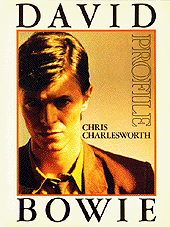| HOME | BOOKS | COMICS | RECORDS | NEWS | PEOPLE | PICTURES | ORDERS | HISTORY | office@savoy.abel.co.uk |
|
|
David Bowie: Profile (OUT OF PRINT) Chris Charlesworth 1981 b/w and colour illustrated 272mm x 204mm First publication Packaged for Proteus Books 96pp ISBN 0 906071 67 4 (soft cover) ISBN ? (hard cover) |
|
 |
| OK text by Bowie's ex-PR man at RCA, Chris Charlesworth, given beef by the pictures and captions (mainly supplied by Savoy shop manager, Bowie fan Thomas Sheridan). Some of the latter tell an alternative story, such as the borrowing in Bowie's Diamond Dogs from the post-apocalyptic scenario of Harlan Ellison's novella , A Boy and his Dog. Another little known fact is that the British Phonographic Institute once pressed up a bootleg called David Bowie: The Wembley Wizard Touches the Dial, used to ensnare bootleggers (including Savoy, yak!) in their (1979) Operation Moonbeam sting (detailed at length in Clinton Heylin's history of bootleg recordings, Great White Wonders). When Proteus Books went into liquidation in 1987 this Savoy title was repackaged by Music Sales supremo Bob Wise under his Bobcat Books imprint. Retitled David Bowie: The Archive, it bears his company's copyright and the by-line, "Compiled and written by Chris Charlesworth". Charlesworth did not, of course, 'compile' our book—this was done by our own Thomas Sheridan. The ruse enabled Wise to profit from a perennially-selling title. Wise poached Savoy's planned book on Jimmy Page, Tangents Within a Framework, after he persuaded author Howard Mylett to break his contract with Savoy. |
|
|
"The profuse-photo coffee-table biog doesn't suit all artists, but for Bowie perhaps it's the only way. His career is as much concerned with the shuffling of visuals as it is with sound—a real music for chameleons. He is a whiteness on which images can be layered, no matter from what the source or discipline. So this time-travel of sloughed-off skins and discarded personas is as important as the album sleeves, and perhaps more so than what lies within those sleeves! And although (according to Charlesworth) "the pop process is foreign to his nature—and more importantly, to the nature of his art", Bowie suggests his own alternative strategy: "diversify and become a nuisance everywhere". Such rhetoric, such ambition, is not entirely unprecedented, but the odds against their consummation are prohibitive. The whole shambling turgid beast of Rock is riddled with immovable traditions and sales-enforced inertia; conventions and conservatisms as much related to audience antipathy as to industry structure. It is a mechanism so deeply entrenched, so timelagged and hide-bound that the smart, fast, sharp ideas (McLaren's cassetisation), or the intelligent subtlety of lyrical/musical innovation are dumped and ignored in favour of the regulation known quantities. Bowie's success is unique in that he's lived his blueprint all ways, through several lives. "As soon as a Rock'n'Roller becomes an archetype" he said in '76, "he's served his purpose."
In this book he's pictured performing with Iggy Pop, and with Bing Crosby—and by shucking off successive archetypes he's been able to cover all the spaces between them, and then go beyond both. Yet he's less the innovator than the catalyst, his use of ideas is as much flirtation as it is thievery and only slightly is it a real distillation of Bowie. Each period—visual and musical—had its mentors, its alter-ego's, its gurus, and these relationships are as important as the thin white Duke himself. Be it Ronson for the Ziggy phase, be it Fripp or Eno, Lindsay Kemp, De fries, or Lou Reed, be it the intellectually invigorating cultural debris left in the wake of Burroughs, Jean Genet, Brecht, Harlan Ellison, or, Andy Warhol, they all played their part, and their roles are all here-in photographically documented. Not that this eclecticism denigrates Bowie. Real artists invent themselves, and none more than this cracked actor! Indeed, insofar as '80s culture is more about mix and match cannibalism than originality then Bowie is the ideal cipher for this planned obsolescence artform. It don't matter if he ever was/is Gay/Bi, it's not important if he ever was/is fascist. The only truth worth recording is that it was the correct gesture/guise for the moment. You know Bowie's history of scene-shifting, so it would be tedious to regurgitate it now; suffice it to say that everything you most remember about Bowie is here, in this book—the bio-file from Brixton Mod to the famous 'man's dress' MM cover that launched Hunky Dory, then the terminal weirdness of Ziggy/Diamond Dogs, then Bowie kissing Lou Reed, the Nazi salute, the movie stills, the sexually explicit Playboy interview, the Iggy tour, the White Light tour, Berlin, clear through to the Ashes to Ashes step by step video. There's also a full appendix of bootlegs and a mass of Bowie trivia for devotees. Charlesworth (former editor of MM as well as Bowie's press officer) writes with authority, despite stating that Life on Mars was culled from Aladdin Sane (instead of Hunky Dory) and that the Sorrow original came from the Merseybeats (instead of Rick Derringer's old band the McCoys, although I'd have accepted the UK cover by the Merseys). But, nit picking aside, this is the best book on Bowie I've read. And, incidentally, there are publishers' in-references aplenty that the uninformed reader will miss. Why, for example, are so many of Bowie's' seminal influence' books published by Savoy? And what connection does the Dave Britton cited in the 'Operation Moonbeam' bootleg bust (page 84) have to the manic Savoy Books artist/director of the same name? I ain't telling. Buy your own copy... " HOT PRESS |
| Main Book Page | Author Index | Book Covers Index | Title Index | Articles | The Revenant Zone | Links |